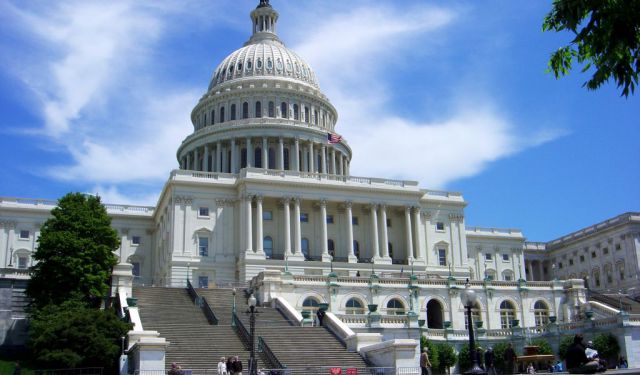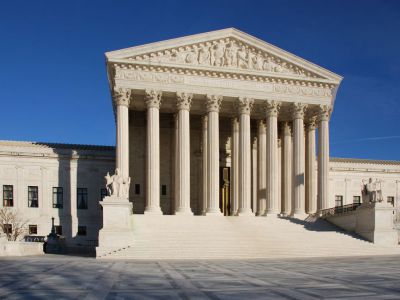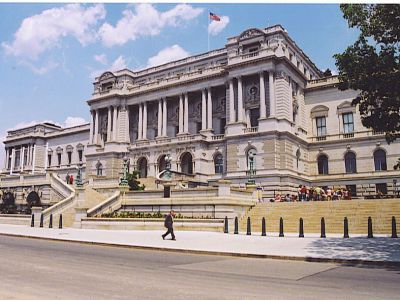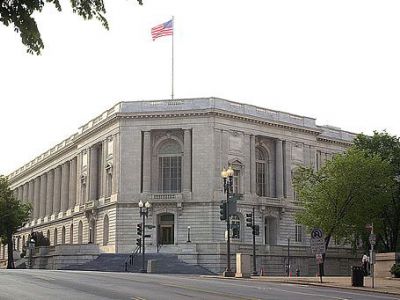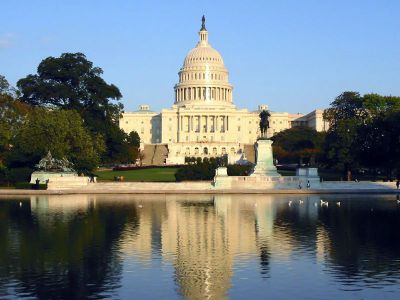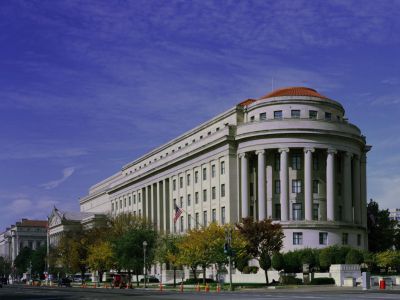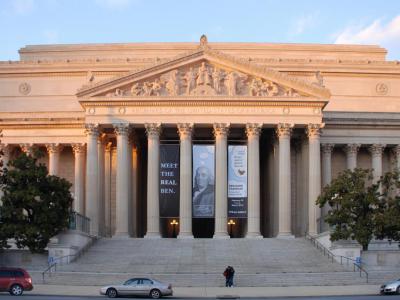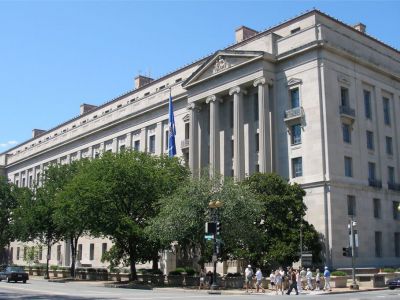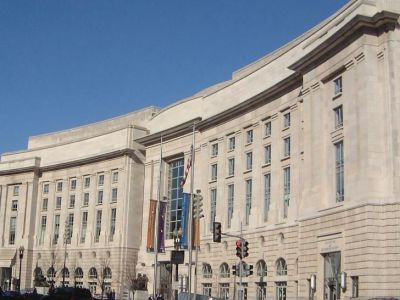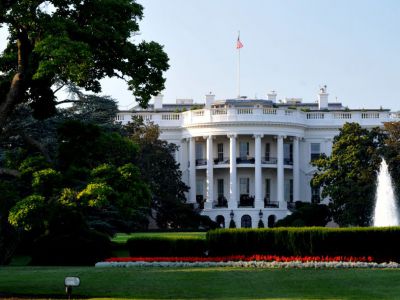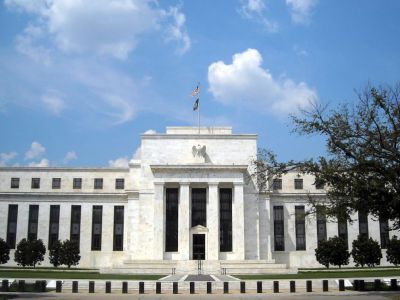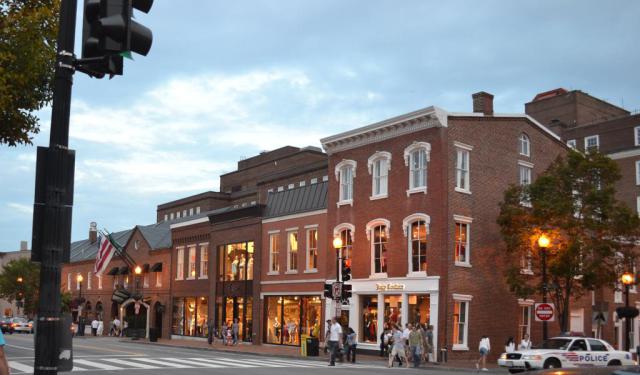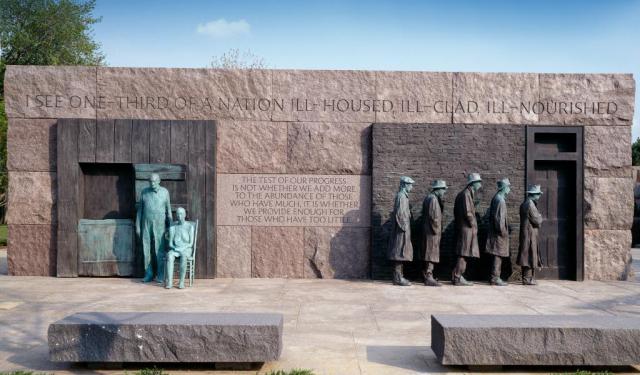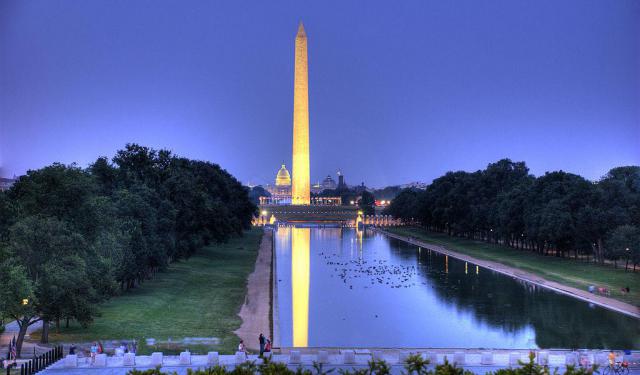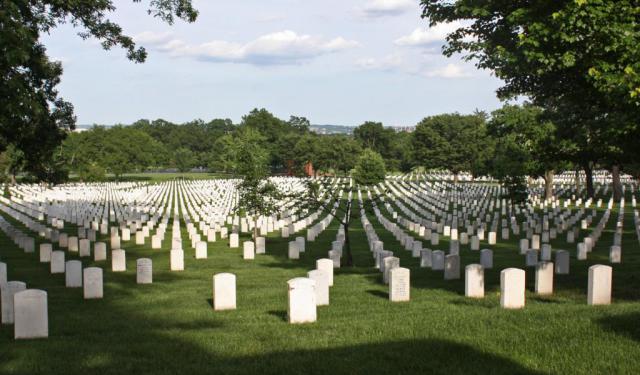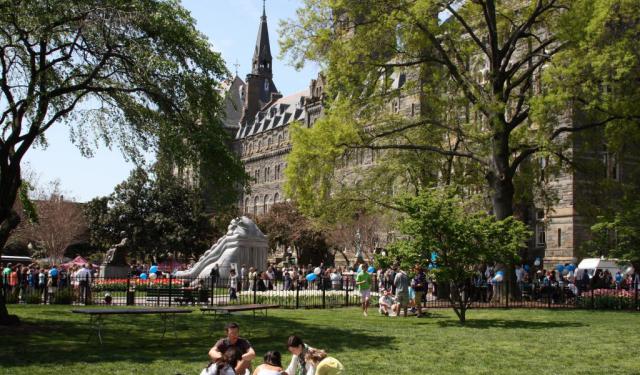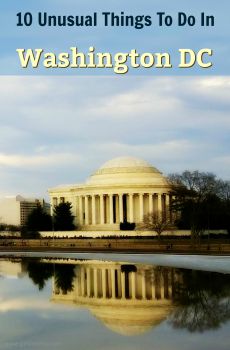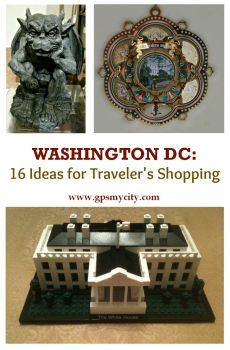Federal Buildings Walking Tour (Self Guided), Washington D.C.
The capital of the United States is home to several notable federal buildings that hold significant historical, architectural, and governmental value.
Among the stately “emblems of authority” in Washington D.C. perhaps the most prominent is the official residence and workplace of the President of the United States – The White House. This resplendent mansion at 1600 Pennsylvania Avenue has epitomized the essence of presidential power in the country since its completion in 1800.
The United States Capitol, a majestic seat of democracy, houses the legislative branch of the U.S. federal government and is an iconic symbol of American democracy, situated on Capitol Hill. Also found here is the highest judicial body in the country, the Supreme Court of the United States, housed in the neoclassical-style building – a dignified sanctuary of justice, where the nation's most profound legal principles are enshrined.
The Library of Congress, the largest library in the world, is a true treasury of human knowledge, where “the past, present, and future harmonize in the written word.”
The Pentagon – the headquarters of the United States Department of Defense – although not technically in Washington D.C., situated across the Potomac River in Arlington, Virginia, is an architectural marvel of military might, symbolizing the nation's commitment to safeguarding freedom.
The Harry S. Truman Building, located near the National Mall, serves as the headquarters for the Department of State which is responsible for U.S. foreign policy and international relations.
If you aim to capture the architectural splendor and symbolic grandeur of these and other federal buildings in Washington D.C., follow this self-guided walk.
Among the stately “emblems of authority” in Washington D.C. perhaps the most prominent is the official residence and workplace of the President of the United States – The White House. This resplendent mansion at 1600 Pennsylvania Avenue has epitomized the essence of presidential power in the country since its completion in 1800.
The United States Capitol, a majestic seat of democracy, houses the legislative branch of the U.S. federal government and is an iconic symbol of American democracy, situated on Capitol Hill. Also found here is the highest judicial body in the country, the Supreme Court of the United States, housed in the neoclassical-style building – a dignified sanctuary of justice, where the nation's most profound legal principles are enshrined.
The Library of Congress, the largest library in the world, is a true treasury of human knowledge, where “the past, present, and future harmonize in the written word.”
The Pentagon – the headquarters of the United States Department of Defense – although not technically in Washington D.C., situated across the Potomac River in Arlington, Virginia, is an architectural marvel of military might, symbolizing the nation's commitment to safeguarding freedom.
The Harry S. Truman Building, located near the National Mall, serves as the headquarters for the Department of State which is responsible for U.S. foreign policy and international relations.
If you aim to capture the architectural splendor and symbolic grandeur of these and other federal buildings in Washington D.C., follow this self-guided walk.
How it works: Download the app "GPSmyCity: Walks in 1K+ Cities" from Apple App Store or Google Play Store to your mobile phone or tablet. The app turns your mobile device into a personal tour guide and its built-in GPS navigation functions guide you from one tour stop to next. The app works offline, so no data plan is needed when traveling abroad.
Federal Buildings Walking Tour Map
Guide Name: Federal Buildings Walking Tour
Guide Location: USA » Washington D.C. (See other walking tours in Washington D.C.)
Guide Type: Self-guided Walking Tour (Sightseeing)
# of Attractions: 10
Tour Duration: 2 Hour(s)
Travel Distance: 4.9 Km or 3 Miles
Author: DanaOffice
Sight(s) Featured in This Guide:
Guide Location: USA » Washington D.C. (See other walking tours in Washington D.C.)
Guide Type: Self-guided Walking Tour (Sightseeing)
# of Attractions: 10
Tour Duration: 2 Hour(s)
Travel Distance: 4.9 Km or 3 Miles
Author: DanaOffice
Sight(s) Featured in This Guide:
- Supreme Court
- Library of Congress
- House of Representatives Office Buildings
- U.S. Capitol
- Federal Trade Commission
- National Archives
- Robert F. Kennedy Department of Justice
- Ronald Reagan Building
- White House
- Federal Reserve Board Building
1) Supreme Court
The Supreme Court of the United States is located just east of the United States Capitol, and its oversight falls under the Architect of the Capitol. It received the distinction of being designated a National Historic Landmark on May 4, 1987.
The Supreme Court Building was designed by architect Cass Gilbert and stands four stories tall (92 feet) above ground. Construction began on October 13, 1932, and was completed in 1935, staying within the budget of $9.74 million authorized by Congress, with a total cost of $94,000. It was designed to reflect the importance and dignity of the Court and the Judiciary as an equal and independent branch of the U.S. government, serving as a symbol of the national ideal of justice at the highest level.
The public-facing façade of the Supreme Court Building is constructed from marble quarried in Vermont, while the courtyards facing the interior are made of Georgian marble. Most of the interior spaces are adorned with Alabama marble, except for the Courtroom itself, which is decorated with Spanish ivory vein marble. For the 24 columns in the Courtroom, architect Gilbert specifically chose ivory buff and golden marble from the Montarrenti quarries near Siena, Italy.
The west façade of the building, which faces the Capitol and is essentially the "front" of the court, features the motto "Equal Justice Under Law," while the east façade carries the motto "Justice, the Guardian of Liberty."
The Supreme Court Building was designed by architect Cass Gilbert and stands four stories tall (92 feet) above ground. Construction began on October 13, 1932, and was completed in 1935, staying within the budget of $9.74 million authorized by Congress, with a total cost of $94,000. It was designed to reflect the importance and dignity of the Court and the Judiciary as an equal and independent branch of the U.S. government, serving as a symbol of the national ideal of justice at the highest level.
The public-facing façade of the Supreme Court Building is constructed from marble quarried in Vermont, while the courtyards facing the interior are made of Georgian marble. Most of the interior spaces are adorned with Alabama marble, except for the Courtroom itself, which is decorated with Spanish ivory vein marble. For the 24 columns in the Courtroom, architect Gilbert specifically chose ivory buff and golden marble from the Montarrenti quarries near Siena, Italy.
The west façade of the building, which faces the Capitol and is essentially the "front" of the court, features the motto "Equal Justice Under Law," while the east façade carries the motto "Justice, the Guardian of Liberty."
2) Library of Congress (must see)
The Library of Congress was founded in 1800 during President John Adams' administration with the primary purpose of providing Congress with the necessary books for their legislative duties. Thomas Jefferson played a significant role in emphasizing the importance of the library, and in 1802, he signed a law that outlined its structure and permitted the President and Vice-President to borrow books from it. Unfortunately, during the War of 1812, the Library of Congress was destroyed when British troops burned down the Capitol in 1814.
In response to this loss, President Jefferson generously offered his personal collection of 6,487 books to replace those lost in the fire. Congress accepted his offer in 1815, compensating him approximately $24,000 for his library. Regrettably, another fire occurred in 1851, destroying roughly 4,000 books from President Jefferson's donation along with an additional 31,000 volumes. Following some debates about its management, the Smithsonian Institution transferred approximately 40,000 volumes to the Library in 1866.
Subsequently, the Library of Congress underwent substantial expansion, amassing 840,000 volumes by 1897. During this period, there was a growing sentiment that the Library should serve as a national resource. Programs were initiated to make the collection accessible to individuals with physical disabilities. In addition to books, the Library houses an extensive collection of manuscripts, sheet music, maps, sound recordings, and films, making it an extraordinary repository of knowledge.
Today, the Library of Congress boasts the world's largest collection of books and manuscripts. While it is a public resource, only members of Congress, high-ranking officials, and Supreme Court Justices have the privilege to check out books. Nevertheless, anyone is welcome to utilize the books stored in three separate buildings on Capitol Hill in Washington, D.C. These libraries are interconnected by tunnels, streamlining the security process for visitors.
Why You Should Visit:
A world treasure that has one of the most beautiful building interiors in Washington, D.C. and worldwide!
There are permanent exhibits (first printed book – Gutenberg Bible from 1455) as well as temporary ones at any times.
Tip:
Definitely go online beforehand and register for your reader card; then, when you get there, just show your ID and the world of learning is open to you.
Tours are free and about an hour long. While you can see all the areas on the tour on your own, they are explained nicely by the tour guide.
There is a tunnel that connects the LoC and the US Capitol so you can view both without going outside.
If coming from the Capitol Building, you don't have to pass through the security check again (but if planning on visiting the Capitol Building from here, you will need to go through the security check, even if you came from this building before).
In response to this loss, President Jefferson generously offered his personal collection of 6,487 books to replace those lost in the fire. Congress accepted his offer in 1815, compensating him approximately $24,000 for his library. Regrettably, another fire occurred in 1851, destroying roughly 4,000 books from President Jefferson's donation along with an additional 31,000 volumes. Following some debates about its management, the Smithsonian Institution transferred approximately 40,000 volumes to the Library in 1866.
Subsequently, the Library of Congress underwent substantial expansion, amassing 840,000 volumes by 1897. During this period, there was a growing sentiment that the Library should serve as a national resource. Programs were initiated to make the collection accessible to individuals with physical disabilities. In addition to books, the Library houses an extensive collection of manuscripts, sheet music, maps, sound recordings, and films, making it an extraordinary repository of knowledge.
Today, the Library of Congress boasts the world's largest collection of books and manuscripts. While it is a public resource, only members of Congress, high-ranking officials, and Supreme Court Justices have the privilege to check out books. Nevertheless, anyone is welcome to utilize the books stored in three separate buildings on Capitol Hill in Washington, D.C. These libraries are interconnected by tunnels, streamlining the security process for visitors.
Why You Should Visit:
A world treasure that has one of the most beautiful building interiors in Washington, D.C. and worldwide!
There are permanent exhibits (first printed book – Gutenberg Bible from 1455) as well as temporary ones at any times.
Tip:
Definitely go online beforehand and register for your reader card; then, when you get there, just show your ID and the world of learning is open to you.
Tours are free and about an hour long. While you can see all the areas on the tour on your own, they are explained nicely by the tour guide.
There is a tunnel that connects the LoC and the US Capitol so you can view both without going outside.
If coming from the Capitol Building, you don't have to pass through the security check again (but if planning on visiting the Capitol Building from here, you will need to go through the security check, even if you came from this building before).
3) House of Representatives Office Buildings
There are in total four buildings used by the United States House of Representatives as offices. After the initially allocated spaces at the US Capitol got very crowded, the first purpose-built property to relive pressure for office space was the Cannon House Office Building, located on the south side of the Capitol, connected to it by an underground passage. Completed in 1908, this was also crowded almost immediately, so the Representatives had to rent additional quarters to accommodate themselves.
Their second property, smallest of them all, is the Longworth House Office Building, completed in 1933, located south of the Capitol. This building has 251 congressional offices and suites, plus 12 committee rooms. There is a large assembly room that is currently used by the Ways and Means Committee. After its construction, the Cannon House Office Building was remodeled and the number of offices there dropped from 397 to 85 office suites, 23 committee rooms and 10 single room offices.
The Rayburn House Office Building is the newest, having been completed in 1965. Biggest of the Office Buildings, it houses 169 representatives. This building has an underground transportation system, called the Capital Subway System, that connects it to the Capitol. There is also a pedestrian tunnel that links all the Congressional Office Buildings on the Hill.
Their second property, smallest of them all, is the Longworth House Office Building, completed in 1933, located south of the Capitol. This building has 251 congressional offices and suites, plus 12 committee rooms. There is a large assembly room that is currently used by the Ways and Means Committee. After its construction, the Cannon House Office Building was remodeled and the number of offices there dropped from 397 to 85 office suites, 23 committee rooms and 10 single room offices.
The Rayburn House Office Building is the newest, having been completed in 1965. Biggest of the Office Buildings, it houses 169 representatives. This building has an underground transportation system, called the Capital Subway System, that connects it to the Capitol. There is also a pedestrian tunnel that links all the Congressional Office Buildings on the Hill.
4) U.S. Capitol (must see)
The United States Capitol stands at the opposite end of the National Mall from the Washington Monument. This huge building holds the House of Representatives in the south wing, and the Senate in the north wing. There are 540 rooms, five floors and the beautiful Capitol Rotunda which additionally houses art and sculptures. The artwork depicts events and figures from American history.
After much wrangling about the design, the Capitol cornerstone was laid by President Washington, who was dressed for the occasion in full Mason attire, on September 18, 1793. The north wing was completed in 1800. For several decades, beginning when the federal government moved to Washington in the fall of 1800, the Capitol building was used for Sunday religious services as well as for governmental functions.
Soon after the building was fully completed in 1811, the Capitol was partially damaged in August 1814 during the burning of Washington in the course of the War of 1812. The burnt down portions were rebuilt and the Rotunda was added in 1826. In the 1850s the Capitol was expanded further with a new cast-iron dome added to replace the wooden Rotunda, following which several more renovations and expansions have been made. Among them is The Apotheosis of Washington fresco painted on the inside of the dome, visible through the oculus from the Rotunda floor.
The Capitol is open to visitors and offers free tour. Tickets are available at the Capitol Visitor Center on the first come-first served basis. This center is new, having opened in 2008. There is a 15-minute orientation film about the Capitol that is well worth viewing.
Visitors to the Capitol can watch Congress in action from designated galleries. Passes are available from the offices of Senators and Representatives. If visiting when Congress is in session, be sure to contact your local official and see government in action. Overseas visitors can apply for the passes at the Senate Appointment Desk and the House Appointment Desk inside the Capitol Building.
Tip:
First off, book your 45-min tour early to avoid missing out and to give yourself a bigger range of time slots.
You'll still have to go to the desk to pick up your ticket by showing the online receipt on your phone.
Get there 30-45 mins before your tour due to security checks before entry (food & drinks are prohibited).
When you've finished your visit, use the tunnel just before the exit to go directly to the Library of Congress (no additional security check).
Interestingly, both the east side and the west side of the Capitol can be designated as the front, so just be aware that “front” is not the best descriptive designation here.
After much wrangling about the design, the Capitol cornerstone was laid by President Washington, who was dressed for the occasion in full Mason attire, on September 18, 1793. The north wing was completed in 1800. For several decades, beginning when the federal government moved to Washington in the fall of 1800, the Capitol building was used for Sunday religious services as well as for governmental functions.
Soon after the building was fully completed in 1811, the Capitol was partially damaged in August 1814 during the burning of Washington in the course of the War of 1812. The burnt down portions were rebuilt and the Rotunda was added in 1826. In the 1850s the Capitol was expanded further with a new cast-iron dome added to replace the wooden Rotunda, following which several more renovations and expansions have been made. Among them is The Apotheosis of Washington fresco painted on the inside of the dome, visible through the oculus from the Rotunda floor.
The Capitol is open to visitors and offers free tour. Tickets are available at the Capitol Visitor Center on the first come-first served basis. This center is new, having opened in 2008. There is a 15-minute orientation film about the Capitol that is well worth viewing.
Visitors to the Capitol can watch Congress in action from designated galleries. Passes are available from the offices of Senators and Representatives. If visiting when Congress is in session, be sure to contact your local official and see government in action. Overseas visitors can apply for the passes at the Senate Appointment Desk and the House Appointment Desk inside the Capitol Building.
Tip:
First off, book your 45-min tour early to avoid missing out and to give yourself a bigger range of time slots.
You'll still have to go to the desk to pick up your ticket by showing the online receipt on your phone.
Get there 30-45 mins before your tour due to security checks before entry (food & drinks are prohibited).
When you've finished your visit, use the tunnel just before the exit to go directly to the Library of Congress (no additional security check).
Interestingly, both the east side and the west side of the Capitol can be designated as the front, so just be aware that “front” is not the best descriptive designation here.
5) Federal Trade Commission
The Federal Trade Commission (FTC) was established in 1914 by President Woodrow Wilson. Its main purpose is to protect American consumer, prevent monopolies, and to investigate antitrust issues. After moving to several different buildings, the FTC finally settled in the Apex building, completed in 1937, now commonly referred to as the Federal Trade Commission building. Its cornerstone was laid by President Franklin Delano Roosevelt using the same trowel that Washington had used when laying the cornerstone for the U.S. Capitol.
The commission is composed of five members nominated by President and confirmed by Senate. Commissioners are appointed to a seven year term and these terms are staggered so that there is no more than one vacancy appointed per year. However, the commissioners may retire before their term expires and that would necessitate a new appointment. There are never to be more than three members of the same political party sitting on the commission. In addition to protecting consumers and monitoring for unfair competition practices, the FTC is also tasked with providing expert knowledge regarding economic decisions the FTC makes. It was instrumental in the National Do Not Call Registry. It is also in charge of developing policies surrounding the Internet, such as fraud and privacy. The building is located at 600 Pennsylvania Ave NW.
The commission is composed of five members nominated by President and confirmed by Senate. Commissioners are appointed to a seven year term and these terms are staggered so that there is no more than one vacancy appointed per year. However, the commissioners may retire before their term expires and that would necessitate a new appointment. There are never to be more than three members of the same political party sitting on the commission. In addition to protecting consumers and monitoring for unfair competition practices, the FTC is also tasked with providing expert knowledge regarding economic decisions the FTC makes. It was instrumental in the National Do Not Call Registry. It is also in charge of developing policies surrounding the Internet, such as fraud and privacy. The building is located at 600 Pennsylvania Ave NW.
6) National Archives
The National Archives is a repository of some of the United States' most cherished historical documents. Within its confines, you'll find significant pieces such as the Constitution, the Bill of Rights, and the Declaration of Independence. These invaluable documents, collectively referred to as the Charters of Freedom, are prominently displayed in the Rotunda for the Charters of Freedom, where they are always on view.
Additionally, there are accessible public vaults containing over 1,000 records related to American democracy. Among the treasures held here are telegrams sent by Abraham Lincoln to his generals and handwritten notes penned by George Washington. These records are divided into five separate vaults, each named after a theme from the Constitution's preamble, covering topics like law, citizenship, war, milestones, and record-keeping for the benefit of future generations.
Visitors can also take advantage of the William G. McGowan Theater, which screens informative films about the National Archives and the Charters of Freedom. Furthermore, there are numerous exhibits to explore in the Lawrence F. O'Brian Gallery.
The National Archives and Records Administration is conveniently located on Pennsylvania Avenue, situated between 7th and 9th streets. Access to the Rotunda is granted from Constitution Avenue. Admission is free, but during peak tourist seasons, you can reserve a nonrefundable ticket for entry. Those with tickets should use the special events door on Constitution Ave. to gain access.
Additionally, there are accessible public vaults containing over 1,000 records related to American democracy. Among the treasures held here are telegrams sent by Abraham Lincoln to his generals and handwritten notes penned by George Washington. These records are divided into five separate vaults, each named after a theme from the Constitution's preamble, covering topics like law, citizenship, war, milestones, and record-keeping for the benefit of future generations.
Visitors can also take advantage of the William G. McGowan Theater, which screens informative films about the National Archives and the Charters of Freedom. Furthermore, there are numerous exhibits to explore in the Lawrence F. O'Brian Gallery.
The National Archives and Records Administration is conveniently located on Pennsylvania Avenue, situated between 7th and 9th streets. Access to the Rotunda is granted from Constitution Avenue. Admission is free, but during peak tourist seasons, you can reserve a nonrefundable ticket for entry. Those with tickets should use the special events door on Constitution Ave. to gain access.
7) Robert F. Kennedy Department of Justice
The Robert F. Kennedy Department of Justice building is one of the most recognizable edifices in Washington D.C. Trapezoidal in shape, it stands at the intersections of Pennsylvania Avenue, Constitution Avenue, 9th Street and 10th Street NW, and forms part of the Federal Triangle, being very close to the National Archives and the Internal Revenue Service Building. The physical address is 950 Pennsylvania Avenue NW, and you can get to the location quickly from the National Mall or the J. Edgar Hoover Building.
Back in the early 20th century, the Department of Justice needed a home and The United States also needed a place to house the Attorney General’s Office. The need was finally met in 1935. The architectural firm responsible for the design was Zantzinger, Borie and Medary of Philadelphia, PA who made good use of the modern Art Deco style that is seen in many of the buildings in the area. In addition to its unique shape, the building is also noted as a wonderful example of the so-called “Classical Revival” architectural style.
In 2001, the United States Congress passed legislation to rename the location after Robert F. Kennedy, who was the 64th Attorney General of the United States.
Back in the early 20th century, the Department of Justice needed a home and The United States also needed a place to house the Attorney General’s Office. The need was finally met in 1935. The architectural firm responsible for the design was Zantzinger, Borie and Medary of Philadelphia, PA who made good use of the modern Art Deco style that is seen in many of the buildings in the area. In addition to its unique shape, the building is also noted as a wonderful example of the so-called “Classical Revival” architectural style.
In 2001, the United States Congress passed legislation to rename the location after Robert F. Kennedy, who was the 64th Attorney General of the United States.
8) Ronald Reagan Building
If you want to take in a site in Washington D.C. that is a bit more modern in nature, you may want to visit the Ronald Reagan Building and International Trade Center, located at 1300 Pennsylvania Ave NW, not far off the Federal Triangle.
This example of modern historical architecture houses many international businesses and conference space. Interestingly, the location has also become famous lately for holding wedding receptions. Among other amenities, it houses a first class food court and a wonderful Italian Restaurant, called Aria’s.
You may also want to visit the building on a day when the famous Capitol Steps Comedy troupe is performing, famous for their music and plays based on political satire. There are also many free outdoor music events held here throughout summer months.
The Ronald Reagan Building represents a first of a kind approach in federal buildings by housing both governmental offices and private sector businesses. Following the attack of 9/11, there has been some tightening of security in the building, though. Still, there is plenty of reason to go and visit this location during a trip to Washington D.C.
This example of modern historical architecture houses many international businesses and conference space. Interestingly, the location has also become famous lately for holding wedding receptions. Among other amenities, it houses a first class food court and a wonderful Italian Restaurant, called Aria’s.
You may also want to visit the building on a day when the famous Capitol Steps Comedy troupe is performing, famous for their music and plays based on political satire. There are also many free outdoor music events held here throughout summer months.
The Ronald Reagan Building represents a first of a kind approach in federal buildings by housing both governmental offices and private sector businesses. Following the attack of 9/11, there has been some tightening of security in the building, though. Still, there is plenty of reason to go and visit this location during a trip to Washington D.C.
9) White House (must see)
The White House address on Pennsylvania Avenue, Washington, D.C. is both home and office of the American President, much as the symbol of the United States. While this is not the first home of American presidents, it has been the home of every American President since John Adams moved in here during his presidency in 1800. The design was made by James Hoban and the construction started with the laying of the cornerstone in 1792. Each president ever since has added their own touch to the people’s house, some big and some small.
The original White House was burned, almost to the ground, by British troops in 1814 during the War of 1812. Rebuilding soon began and was finished by 1817. The South Portico was added in 1824 and the North Portico followed in 1830. The West Wing came during an addition in 1901 and then later the Oval Office was added. A fire of 1929 damaged the West Wing but the damage was repaired, and in the 1930s, a second story and basement were added, upon which the Oval Office was moved to its present location.
By 1948 the building was in need of a serious repair prompted by numerous additions made over the years. Load bearing beams were installed and a complete dismantling of the interior was undertaken. Sadly, most of the glorious handcrafted work was lost during that process. In the 1960s Jacqueline Kennedy oversaw another extensive redecoration of the White House whereby some of the artifacts, previously lost, were brought back and the building returned to its grander days.
Today, the White House has six stories, 132 rooms and various amenities including a tennis court, swimming pool, bowling alley and, of course, the First Garden. Following the attacks of 9/11, the White House is no longer open for tours, except on a very limited basis. All those wanting a tour must ask their Congressional representatives to put them on a list and have background checks completed prior to the visit.
Tip:
The entire tour is self-paced, so you might want to brush up on your White House history (War of 1812, etc) ahead of time, so as to maximize the experience. You will only be visiting the East Wing, so that will limit how much you need to research.
If you're you don't get a tour time, don't be heartbroken. Stand in front of the White House and take a group photo, then head over to the Visitor Center and use the interactive displays where you can see the same rooms.
The original White House was burned, almost to the ground, by British troops in 1814 during the War of 1812. Rebuilding soon began and was finished by 1817. The South Portico was added in 1824 and the North Portico followed in 1830. The West Wing came during an addition in 1901 and then later the Oval Office was added. A fire of 1929 damaged the West Wing but the damage was repaired, and in the 1930s, a second story and basement were added, upon which the Oval Office was moved to its present location.
By 1948 the building was in need of a serious repair prompted by numerous additions made over the years. Load bearing beams were installed and a complete dismantling of the interior was undertaken. Sadly, most of the glorious handcrafted work was lost during that process. In the 1960s Jacqueline Kennedy oversaw another extensive redecoration of the White House whereby some of the artifacts, previously lost, were brought back and the building returned to its grander days.
Today, the White House has six stories, 132 rooms and various amenities including a tennis court, swimming pool, bowling alley and, of course, the First Garden. Following the attacks of 9/11, the White House is no longer open for tours, except on a very limited basis. All those wanting a tour must ask their Congressional representatives to put them on a list and have background checks completed prior to the visit.
Tip:
The entire tour is self-paced, so you might want to brush up on your White House history (War of 1812, etc) ahead of time, so as to maximize the experience. You will only be visiting the East Wing, so that will limit how much you need to research.
If you're you don't get a tour time, don't be heartbroken. Stand in front of the White House and take a group photo, then head over to the Visitor Center and use the interactive displays where you can see the same rooms.
10) Federal Reserve Board Building
The stately edifice on the corner of 20th Street and Constitution Avenue NW in Washington D.C. has been the home of the Federal Reserve Board since October 20, 1937. Dedicated by President Franklin Delano Roosevelt, it stands to this day as an important contribution to American architectural history and design theory. Its architecture was quite daring for the time of the construction.
The architect, Paul Philippe Cret, who had studied art and design at the Ecole des Beaux-Arts in France, used a bold, very modernistic interpretation of classic Beaux-Arts styling to come up with a unique view of the Federal Building. He kept the classical Beaux-Arts style in the columns, while went in a totally new direction with regards to the building’s ornamentation to attain a very clean and elegant look. The pragmatic classicism style is found in the marble ornaments that decorate the doorways, as well as in the design of the Federal Eagle that adorns the fireplace in the board room.
Following an Act of Congress of 1982, the Federal Reserve Board building has been named after of one of its former chairmen, Marriner S. Eccles.
The architect, Paul Philippe Cret, who had studied art and design at the Ecole des Beaux-Arts in France, used a bold, very modernistic interpretation of classic Beaux-Arts styling to come up with a unique view of the Federal Building. He kept the classical Beaux-Arts style in the columns, while went in a totally new direction with regards to the building’s ornamentation to attain a very clean and elegant look. The pragmatic classicism style is found in the marble ornaments that decorate the doorways, as well as in the design of the Federal Eagle that adorns the fireplace in the board room.
Following an Act of Congress of 1982, the Federal Reserve Board building has been named after of one of its former chairmen, Marriner S. Eccles.
Walking Tours in Washington D.C., USA
Create Your Own Walk in Washington D.C.
Creating your own self-guided walk in Washington D.C. is easy and fun. Choose the city attractions that you want to see and a walk route map will be created just for you. You can even set your hotel as the start point of the walk.
Georgetown Walking Tour
Georgetown is a historic neighborhood situated in the northwest quadrant of Washington, DC. Despite its proximity to downtown, this former port area has preserved much of its distinct character. In Georgetown, "old-world charm meets modern allure," they say. Those poetically inclined tend to compare it to "a tapestry of cobblestone dreams and timeless grace."
The... view more
Tour Duration: 2 Hour(s)
Travel Distance: 3.9 Km or 2.4 Miles
The... view more
Tour Duration: 2 Hour(s)
Travel Distance: 3.9 Km or 2.4 Miles
DC Monuments and Memorials Walking Tour
"In the end, it's not the years in your life that count. It's the life in your years," goes the famous quote by Abraham Lincoln.
Indeed, those remembered in Washington, D.C. – the renowned statesmen, politicians, fallen soldiers, and other distinguished persons – had their years filled with life to the brim. What they left behind is a great legacy manifested in historic... view more
Tour Duration: 2 Hour(s)
Travel Distance: 3.6 Km or 2.2 Miles
Indeed, those remembered in Washington, D.C. – the renowned statesmen, politicians, fallen soldiers, and other distinguished persons – had their years filled with life to the brim. What they left behind is a great legacy manifested in historic... view more
Tour Duration: 2 Hour(s)
Travel Distance: 3.6 Km or 2.2 Miles
Washington D.C. Introduction Walking Tour
Washington, D.C., formally the District of Columbia or simply The District, is the capital of the United States and, in many senses, America’s front yard. After the American Revolution, the need for the newly independent nation's federal government to have authority over a capital city and not rely on any state for its maintenance and safety, came in the wake of the Pennsylvania Mutiny of... view more
Tour Duration: 2 Hour(s)
Travel Distance: 5.2 Km or 3.2 Miles
Tour Duration: 2 Hour(s)
Travel Distance: 5.2 Km or 3.2 Miles
Arlington National Cemetery Tour
"The legacy of heroes is the memory of a great name and the inheritance of a great example," a distinguished politician of the 19th century said once.
The historic military necropolis – the Arlington National Cemetery in Arlington, Virginia – is the final resting place for many of America's heroes, whose willingness to sacrifice for their country has earned them the... view more
Tour Duration: 2 Hour(s)
Travel Distance: 4.1 Km or 2.5 Miles
The historic military necropolis – the Arlington National Cemetery in Arlington, Virginia – is the final resting place for many of America's heroes, whose willingness to sacrifice for their country has earned them the... view more
Tour Duration: 2 Hour(s)
Travel Distance: 4.1 Km or 2.5 Miles
Georgetown University Walking Tour
Georgetown University, established in 1789, is America's oldest Catholic and Jesuit institution. Spanning four campuses in Washington, DC, its main undergraduate campus in Georgetown features fifty-four buildings across 104 acres.
With its Gothic and Georgian architecture, serene green spaces, and Jesuit traditions, the university promotes academic excellence and global engagement. For... view more
Tour Duration: 2 Hour(s)
Travel Distance: 2.1 Km or 1.3 Miles
With its Gothic and Georgian architecture, serene green spaces, and Jesuit traditions, the university promotes academic excellence and global engagement. For... view more
Tour Duration: 2 Hour(s)
Travel Distance: 2.1 Km or 1.3 Miles
Useful Travel Guides for Planning Your Trip
10 Unusual Things to Do in Washington DC
You might be inclined to think that the capital of the United States consists solely of museums and monuments, but that couldn’t be further from the truth. As a local, I’ve found that there are so many more things to do in this city than just the main tourist highlights. Read on to learn 10 of...
Traveler's Guide to Washington DC: 16 Souvenirs to Bring Home
The capital of the United States is an attraction in its own right and many things that have originated here or in the nearby areas are of great cultural and historic significance. To decide which of them can make for an ideal souvenir for you to bring home, check out the proposed list of local...
7 Chocolate Destinations in Washington D.C.
Let’s be honest, you hear the words "Washington, D.C." and you think politics, history, museums, etc. You can’t take five steps in the city without being surrounded by history. As important as all that culture is, it’s also a bit overwhelming. Make it fun by exploring Washington,...
The Most Popular Cities
/ view all
